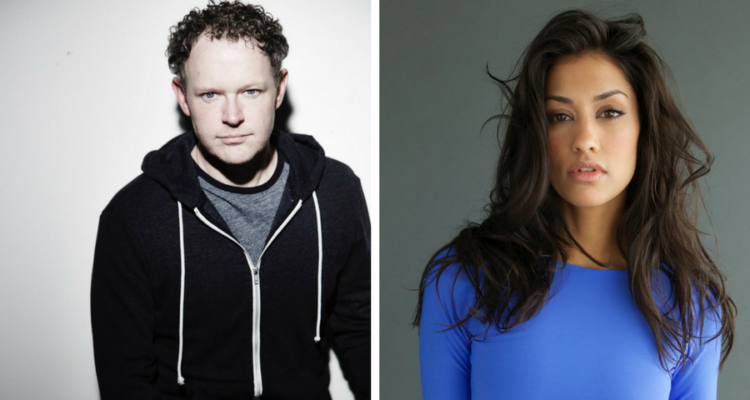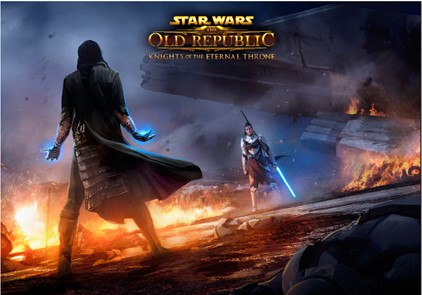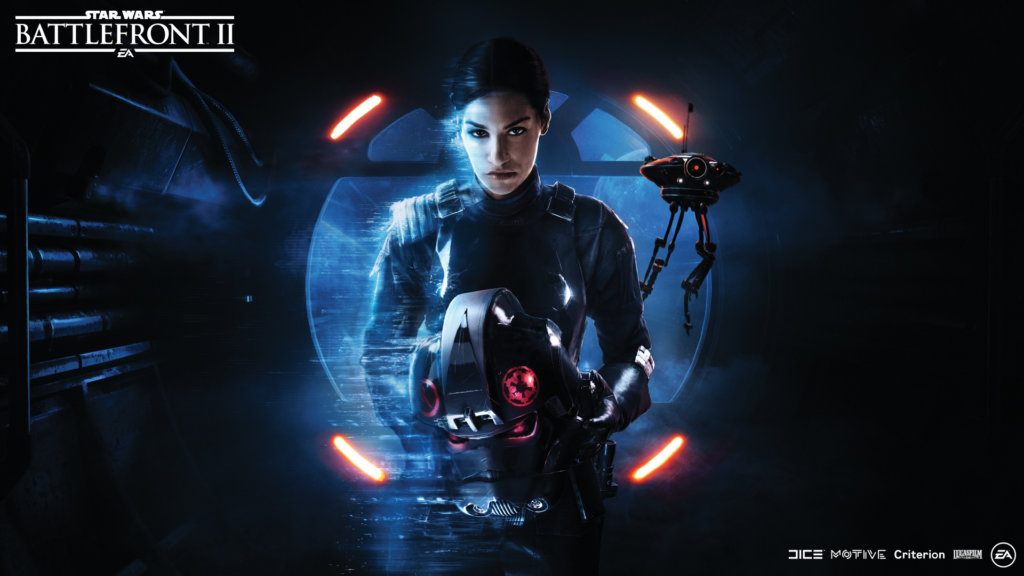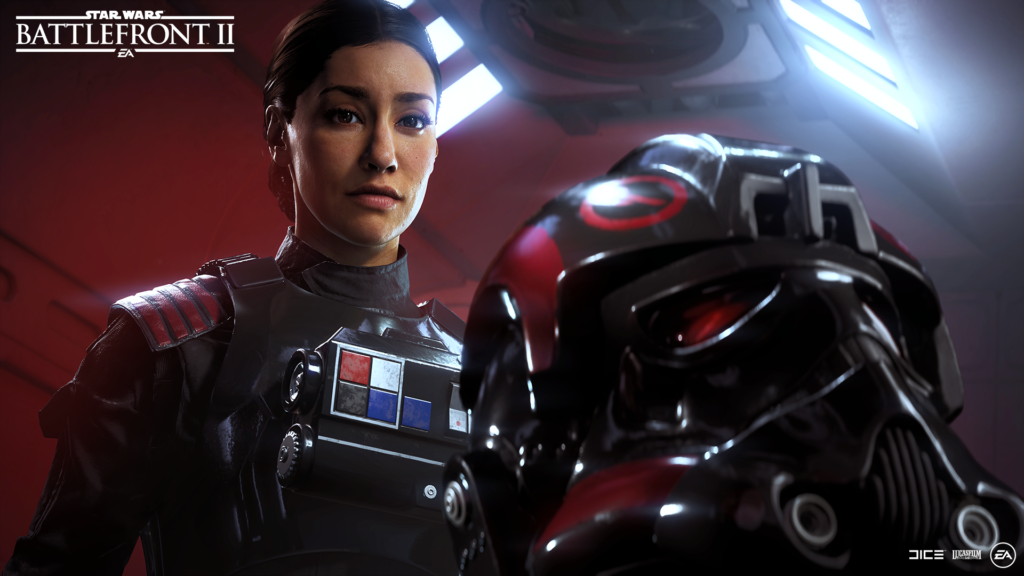
At first glance, Janina Gavankar and Gordy Haab would seem to travel in different Hollywood circles. Gavankar is often recognized for her television roles on True Blood, The League, and Sleepy Hollow, or as a tireless campaigner for diversity in Hollywood and beyond. (She is also a huge techie and is famously known as one of the earliest adopters of Twitter back in 2006.)
Haab boasts a resume no less impressive, but in a different arena, as an award-winning composer for dozens of cult-favorite video games, including the recently released Star Wars: Battlefront II from EA games—making him one of only a handful of musicians on the planet to have composed for the Star Wars universe.
But it was this very Star Wars game that brought these two into the same circle: Gavankar played the lead character in the game’s single-player campaign, a hard-nosed Imperial commander named Iden Versio, and Haab contributed the sweeping musical score, including an original theme for Iden Versio.
Grok Nation brought these two Star Wars nerds together for an epic conversation—in which we learned Gavankar is an impressive musician (specifically, a percussionist) herself—and both Gavankar and Haab identify as pretty big geeks. Oh, and they’re both just a little bit into Star Wars.
Read on as Gavankar interviews Gordy about how he got his start in composing, what influenced his score for Battlefront II, his history with John Williams and, of course, the galaxy far, far away.
JANINA GAVANKAR: I’m so excited to talk to you about all this. My mom is gonna be so excited when she finds out that I got to speak to you today! Before we get into the job itself—Star Wars: Battlefront II—I want to know your Star Wars origin story. How were you first introduced to Star Wars?
GORDY HAAB: I was actually introduced to Star Wars when I was 1 year old. My parents were those kind of parents who actually took their baby to the theater. Of course I don’t remember this, but I saw A New Hope in the theater as a baby.
JG: So you’re the child of nerds?
GH: Oh, absolutely. I had all the Star Wars toys. I grew up with it. It’s basically part of my DNA.
JG: And would you say that John Williams’ music marked your life?
GH: Yeah, and here’s why: I was probably about 6 years old when I saw ET in the theater, and I absolutely loved it. I cried at the end, the whole deal. After we saw the movie, my parents were asking me what I thought of it, asking me to tell them about the story. I didn’t know any of the characters’ names and I could barely recite what the story was, but I picked up my dad’s guitar afterward and started playing the main theme. I latched onto the music specifically, and that was what connected me to the film. That’s the moment in my life when I became extremely interested in the effects of music on film and media. So, yeah, it was very early on that I knew what I wanted to do.
JG: I could honestly talk to you for hours and hours about this, but let’s talk about how you got your start in composing.
GH: I spent five or six years scoring short films, student films, low-budget horror movies. I probably scored, in all, 60 or 70 feature-length, low-budget horror films. And then I sort of branched out from there.
JG: Okay, so you start working for half a decade, proving your salt—I mean really, guys, go to IMDb, he’s worked his ass off for, at this point, 16 years—and then you work on a game for PlayStation 2 called Indiana Jones and the Staff of Kings. Was that your first time working in the world of John Williams?
GH: It was technically my second. It’s kind of a cool story: Staff of Kings was my first video game, and I had, maybe six months prior to that, written the score for a YouTube Star Wars fan film called Ryan vs. Dorkman 2. It was just two guys fighting with lightsabers in their street clothes—it was not necessarily Star Wars-themed other than the lightsabers and the fact that there were well-choreographed fight scenes. It got really popular on YouTube back when YouTube was just becoming a thing. Somebody at LucasArts saw it when they were looking for composers for Staff of Kings, so they reached out, and that’s how I ended up getting the gig for my first game. And it led to my next game, which was Star Wars: The Old Republic.

JG: So once you officially had the “Lucasfilm stamp” so to speak—did you need to study John Williams’ work? Or at this point is the music so in your body and soul that you can just drop right in?
GH: At the beginning, I thought that I needed to study. I couldn’t find all of the copies of scores that I wanted, though, so I actually transcribed a lot of the scores for Star Wars.
JG: Oh. My. Lord. You are such a special kind of nerd. I love you so much.
GH: [laughs] Yeah, I did that a lot while preparing for Star Wars: The Old Republic. I probably spent a good part of three months just really digging into the scores. And then I started to realize that it was actually making it harder to write, so I forgot about all that stuff and just started writing what came naturally to me. After that, if I was studying anything, I’d go to the sources that were John’s inspirations, like Igor Stravinsky or Dmitri Shostakovich, the classical, professional composers that inspired him. I figure, I’ve already got his sound down, so let’s go to the source of the source. And that worked better.
JG: That’s smart. Because then it’s not a reference of a reference, you’re just referencing the same source material.
GH: Yeah, I never wanted to do a knockoff. I just wanted to write my music.
JG: Something that fits into the galaxy.
GH: Exactly, but using the same color palette as John Williams.
JG: So, let’s talk about this color palette. How would you explain what these “paints” are? Is it an instrument? Is it a sound? How do you capture that?
GH: His music is very rooted in orchestral writing, so like I said, I dug into a lot of the composers that inspired him. I would say probably 75 percent of what makes his music what it is is the orchestration. And he is a master orchestrator. John tends to write very strident, big, broad melodies for the trumpet section. The trumpets are always voiced in triads and thirds and that kind of thing. That’s sort of his signature sound. All the brass instruments are used in their proper voice, like a choir, so the trumpets are the sopranos, for example, and the french horns are the alto section and tend to play counter-melodies to what the trumpets are doing. Strings are always sort of a veil that’s cast over the brass section; so, you hear the strings but you don’t hear them in the foreground. It’s like you’re listening through them to the brass section, and they’re there to create grandeur and size, like the color that shimmers on top of everything. You might also have a trumpet part as the main melody. Also, you may not even notice it, but there are double or three flutes playing an octave above what the trumpets are playing. And the purpose is to add this icing that shimmers on top of everything. That’s sort of his MO.
Percussion is a key element to a lot of his music as well. The way he uses percussion is very sophisticated. He uses mallet instruments to highlight what characters are doing. If you have a big brass section, you have to keep them blasting away, and you’re not going to hear what the flute is doing. So he might add glockenspiel and vibraphone with the flute so that it’ll help it cut through the texture. John uses instruments in a really clever way to accentuate the instruments that are getting buried, perhaps, by brass, and it helps them pop out of the texture.

JG: I got to hang out with John’s brother, Don. I technically played in a band with him, it was no big deal, anyway…
GH: That’s awesome!
JG: [laughs] Yeah, I told him, “You are the sound of my childhood and you were the reason I wanted to be a percussionist at all.” And it was so emotional talking to him, it was really great. And then I got to hang out with him when Michael Giacchino invited me to a scoring session for Planet of the Apes, and I was just hanging out in the percussion session, just shooting the shit with Don….ah, oh my God!
GH: Yeah, because he’s the timpanist on everything John does!
JG: I know! Okay, okay. Alright. So, now you get a call to do Battlefront II. What information are you given before you start composing? Are you told the general idea of the story?
GH: Battlefront II has two parts, basically: There’s the multiplayer side of the game, and then there’s the single-player campaign, which was much more intensive from a musical standpoint than the multi-player because it was story-driven. So, I had a very early script when I started writing music. For a video game, the composer typically comes on in the middle of the schedule, whereas for a film, they come in at the very end, usually looking at an edited picture and writing music to the picture. At the point that I started writing, I still had no visuals. So I was just going off of the script.
JG: That’s crazy! Did they even tell you who was playing who or anything?
GH: I didn’t know that until about a month into the writing process. And I purposely stayed away from writing anything that had to do with Iden until I knew who was playing the role, until I had some visuals, and until I was able to really fully understand the arc of the character, because it’s so important that that theme is able to translate through multiple emotions, since that’s the biggest arc in the storyline. But for other characters, for more static characters like Garrick, Iden’s father, I wrote those themes first. And then Iden’s theme was actually somewhat of a variation on Garrick’s theme, but it has more of an upreaching, ascending shape to it.
🔈Listen to “Combat Suite,” a track from the Star Wars: Battlefront II here.
JG: When I heard Iden’s theme—first of all, I cried my face off. I was about a month into the process and I was at the motion capture stage and they were like, “We have your theme,” and I hadn’t even thought about the concept that I would have a theme, let alone a Star Wars theme, ever, in my life, in my career. And so I listened to it, started crying, excused myself, came back, and then was like, “May I listen a few more times, please?”
GH: That’s really cool.
JG: But the thing is, there are three distinct elements to it that are so apparent in this theme. One is that she’s Imperial, and that it’s in her DNA. The other two things are that she’s a rock star in ground battle and that she’s also one hell of a pilot, which I feel in that ascension. The first time I heard that, I was like, “Holy shit, he got all parts of her in such a short amount of measures. How is that possible?” And then, of course, there’s the major key version where she wises up and changes her alliance.
GH: And even that is in the main theme itself. The idea of it ascending, of it reaching upward, is my hint at the possibility that she might see light. I wanted to have that in there, but not in any obvious way. Another really important thing with the theme that I wanted to make sure came through was… Well, I’ll backtrack. When John Williams writes themes for characters, there’s a strong difference between a male character and a female character. And I wanted to not differentiate. I wanted to make this theme… it could be a male character, it could be a female character. It doesn’t really matter; it’s a hero, it’s an Imperial—
JG: Thank you! Thank you! That is so dope of you, oh my God. Especially in this day and age, I appreciate you for that.
GH: Yeah, that was really important to me. I think it was a great choice on the part of the writers to make the lead [in Battlefront II] a female character, and I wanted it to not be, “Hey, look, here’s a female hero!” I wanted it to be, “Here’s a hero!” That’s it.
JG: A hero’s a hero.
GH: A hero’s a hero. Doesn’t matter. So I immediately just forgot about how John writes female characters. I wanted to get rid of that and come from a place of, “Here’s a strong, Imperial, militant character that’s smart and strategic.” I wanted the theme to be that way as well. Then there’s an angle that the melody takes, especially when you get to the B section of the main theme, and that’s when it’s sort of hinting at the possibility of her seeing the light, so to speak.

JG: I love that, because when I’m building a character I often think about the sounds that are in the character’s head. What does the radio in their head sound like? One of the reasons Iden is so good at what she does is because, one, she has been bred to be that good, and two, she really loves the culture of how clean and efficient things are. She couldn’t have some romantic, floofy theme going through her head – she feels more comfortable in her flight suit. So, even when she wises up and sees the light, she misses the Empire and their efficiency and the way that they run things. The music in her head has not changed that much, even though she changed her loyalty.
GH: There’s still some sort of sympathy there, even though the character has seen the light and moved to the Rebellion, but at the same time, you can’t change DNA, and you can’t change what’s been learned throughout a lifetime. So, I wanted the score to do the same thing. Even when they’re in a major version of Iden’s theme, there are still dark undercurrents, and there is still a badass kind of sound to it.
JG: Gordy, this is so wonderful, this has been so nice. I grew up only listening to classical music and film scores, so the fact that this happened to me and that we are linked forever, it means a lot to me.
GH: It’s pretty, pretty cool. I gotta say. And we’re both officially part of Star Wars canon, which, you know…
JG: I know! Oh my goodness. I’m crying.
GH: There’s also the fact that I featured mallet percussion instruments in your theme for you specifically…
JG: Are you kidding me right now?!
GH: No, no! I was told, “She’s like, a killer mallet player,” so it’s my little nod to you!
JG: Oh my god. I… I don’t know what to say! That means so much to me. Oh my Lord. Okay, I’m really going to call my mom right now.


Grok Nation Comment Policy
We welcome thoughtful, grokky comments—keep your negativity and spam to yourself. Please read our Comment Policy before commenting.